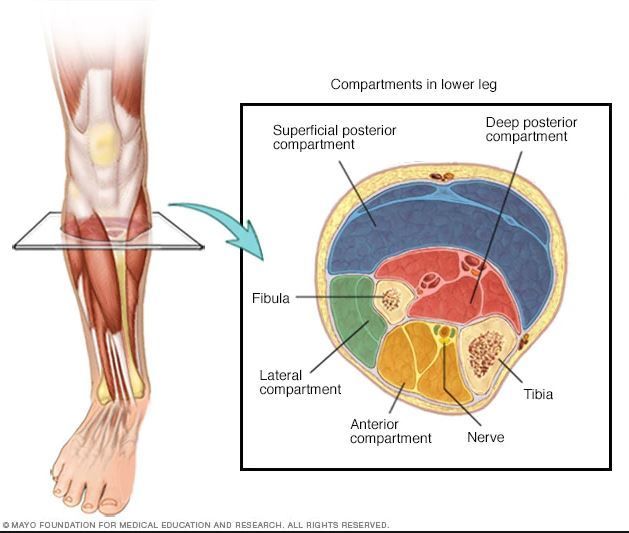Compartment Syndrome Medical Malpractice Attorneys in Pennsylvania
Contact Frischman & Rizza Today
Frischman & Rizza, P.C.

Quick Facts
Fractures account for approximately 75 percent of cases of ACS
ACS is seen more often in patients under 35 years of age
Systems of ACS can include the following:
- Pain out of proportion to apparent injury (early and common finding)
- Persistent deep ache or burning pain
- Paresthesias (onset within approximately 30 minutes to two hours of ACS; suggests ischemic nerve dysfunction)
Source: WebMD
COMPARTMENT SYNDROME MEDICAL MALPRACTICE
Although compartments are located in other parts of the body, such as the abdomen and buttocks, Compartment Syndrome most often occurs in the arms and legs.
Compartment Syndrome can either be acute or chronic. Acute Compartment Syndrome typically occurs after an injury to the arm or leg. It develops quickly and is likely due to fluid buildup within the compartment from swelling and/or blood. The most common cause of Acute Compartment Syndrome is a fracture of one of the bones in the arm or leg. Although not overly common, Acute Compartment Syndrome has been reported to develop in 1 to 10 percent of tibia bone fractures. The other recognized causes of Acute Compartment Syndrome are burns, crush injuries and casts which are applied too tightly.
Conversely, Chronic Compartment Syndrome occurs with repetitive stress. As a result, marathon runners and competitive bicyclists are at increased risk for the development of Compartment Syndrome. In addition to repetitive stress injuries, the use of anabolic steroids has been associated with Chronic Compartment Syndrome. Unlike Acute Compartment Syndrome, which only affects one arm or leg, Chronic Compartment Syndrome usually is bilateral and affects both arms and legs.
Have you been injured?
Contact an attorney at Frischman & Rizza for a free case evaluation
Call Us On
Mechanism Of Injury
Compartment Syndrome is caused by the buildup of pressure within one of the compartments. Following an injury, blood or fluid caused by swelling can accumulate within the compartment. Because the walls of the compartment are formed fascia, which is dense and inelastic, blood or fluid that accumulates within the compartment cause pressure inside the compartment to rise.
The pressure inside a compartment can be measured by a hand-held device called a manometer which works by injecting a small amount of liquid solution into the compartment and then measuring the tissue pressure resistance. If Compartment Syndrome is suspected, these devices are essential to making an accurate diagnosis. Normal compartment pressure measurements are between 0 and 8mmHg. If the pressure inside a compartment reaches 20mmHg, patients often experience pain.
If the pressure continues to rise above 20mmHg, it can significantly limit or prevent blood flow to inside of the compartment, in its entirety. If this occurs, the impacted arm or leg becomes at significant risk for massive tissue damage. This is because when blood flow into the compartment is compromised, the tissue within the compartment no longer receives sufficient quantities of the oxygen-rich blood it requires to remain viable. When Compartment Syndrome occurs over a prolonged period of time, toxins are released into the body from decaying and dying muscle tissue that can accumulate in the kidneys and cause kidney failure.
Diagnosis
Pain Out Of Proportion
Although pain is always present with a fracture, pain that exists after pain medication has been administered or which increases rather than decreases over time and is “out of proportion” to the injury itself, should raise a suspicion as to Compartment Syndrome.
Paresthesia
This is a “pins and needles” sensation or numbness that develops in the injured extremity and is suggestive of nerve damage from rising pressure inside the compartment.
Pallor
When blood flow inside the compartment becomes compromised, the skin becomes pale and cool to the touch.
Paralysis
When muscle and nerve damage occur from increasing compartment pressure, a corresponding inability to move the affected arm or leg will occur.
Pulselessness
The absence of a pulse can be caused by reduced blood flow from increasing pressure inside the compartment.
Compartment Syndrome Treatment
Compartment Syndrome must be treated immediately as the condition will progress without treatment. The only effective treatment for Compartment Syndrome is the performance of an emergent fasciotomy. As shown below, a fasciotomy involves the creation of surgical incisions to relieve pressure that has developed inside the compartment. Time is of the essence as fasciotomies performed within 24 hours of the onset of Compartment Syndrome have a better prognosis. Failure to perform a fasciotomy can lead to the complete loss of function and in some cases, amputation.
Compartment syndrome medical malpractice is a very particular kind of case where there was either a failure to diagnose compartment syndrome, or a failure to treat acute compartment syndrome on a timely basis. If this has happened to you or a loved one, please contact the Compartment Syndrome medical malpractice attorneys at Frischman & Rizza today.
Let's work together
We have no question that our approach will result in better representation, a better experience for you and your family, and a better result.
Call our Pittsburgh Medical Malpractice Attorneys today! (412) 247-7300
Frischman & Rizza, P.C.
7300 Penn Ave, Pittsburgh, PA 15208
Phone:
(412) 247-7300
201 Basin St Unit #8, Williamsport, PA 17701
Phone:
(412) 247-7300
All Rights Reserved | Frischman & Rizza, P.C.
Get in touch
Contact Us
We will get back to you as soon as possible.
Please try again later.
Powered by websitesimpler.com


